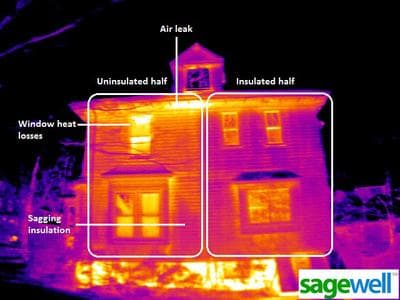Advertisement
New Technology Makes Home Heat Loss Visible
ResumeWinter is definitely settling in, and that's putting our homes to the cold test.
A large amount of heat can literally seep out through old windows and poorly insulated walls and roofs. Now, new technology shows people exactly where it's escaping, and heating efficiency programs are helping homeowners plug those gaps.
Heat Images In Cambridge
The heat is on at St. James Episcopal Church in Cambridge, but the worship hall is chilly. Jason Taylor knows why.
"Oh, can you see that?" Taylor says, as he puffs a smoke stick down a hole to show how cold air is coming into the church. "It’s basically just the air pressure is pouring out of there, so that you’ve got cold air coming up into the church and cooling it off and you want seal that."

Taylor is with the Home Energy Efficiency Team, or HEET, a nonprofit in Cambridge that works with other nonprofits to give them energy audits and efficiency upgrades.
Energy auditors also access new technology now. There are a number of companies, including Sagewell Inc. in Cambridge, that use thermal images to detect heat loss.
"We are looking at our operations screens," says Sagewell's Pasi Miettinen, as he looks online at infrared pictures of the front and sides of some 400,000 private homes and businesses in the state. The screen is aglow with pink and purple in well-insulated spots — and blue where heat is escaping.
Sagewell employees took these pictures while driving around neighborhoods with a thermal camera, which can image 10,000 homes a night. The camera does not see through walls; it only registers heat coming out of buildings.
"This is an interesting house in Belmont and it’s a house that was half-insulated and on our screen here what we see is on the right side of the house, the walls look considerably cooler, they are darker colors," Miettinen says.
Homeowners often receive letters from their utilities comparing their energy use to their neighbors, but Miettinen says thermal technology lets homeowners see exactly where they are losing heat.
"When the homeowner comes through and looks at the report, we'll look at things like insulation and we'll say, 'Your home is in the top 30 percent in heat loss, maybe this is an area that you should focus your attention to,' " he says. "This particular home, in general their windows are in pretty good shape, maybe that’s not a priority for that particular house."
Belmont Embraces The Technology
Belmont has fully embraced the technology. Sagewell has imaged all homes as part of a concerted effort by the town to encourage its residents to reduce greenhouse gas emissions.
"We’ve met with remarkable success," says Jan Kruse, vice chair of the Belmont Energy Committee. Kruse says the thermal images, along with prompts from Sagewell to sign up for energy audits, have residents taking action.
"To date 12 percent of the entire community that heats with gas has requested their scans and a majority of those have also signed up for home energy audits," Kruse says.
“If your house were a boat and it were sinking under water you would understand, you would see where the water was coming in.”
HEET's Audrey Schulman
Sagewell only gives the thermal photo to verified homeowners and earns a referral fee by helping owners connect with companies that make the improvements.
Massachusetts has one of the most generous grant programs for people who want to make their homes energy efficient. The program MassSave, paid for by utility customers, gives free energy audits and pays 75 percent, up to $2,000, toward insulation improvements.
Audrey Schulman, president of HEET, says these incentives should be enough to encourage people, but it’s estimated that less than 2 percent of people a year get an assessment.
"I feel happy that Massachusetts is so efficient and at the same time it depresses me because I see so much inefficiency," Schulman says. "For instance, this church, the heating bill is $1,500 in January and it's primarily only being used on Sunday. That’s incredible to make a congregation pay so much money to pollute the planet."
Schulman says she believes more people would take action if they could see the problem.
"If your house were a boat and it were sinking under water you would understand, you would see where the water was coming in," she says. "But because every house is filling up with cold air, we can’t see it, so the blower door and the thermal camera help us figure out where the house is leaking."
The cold weather makes it obvious, too. And that's the best motivation for buttoning up your home.
This program aired on January 4, 2013.